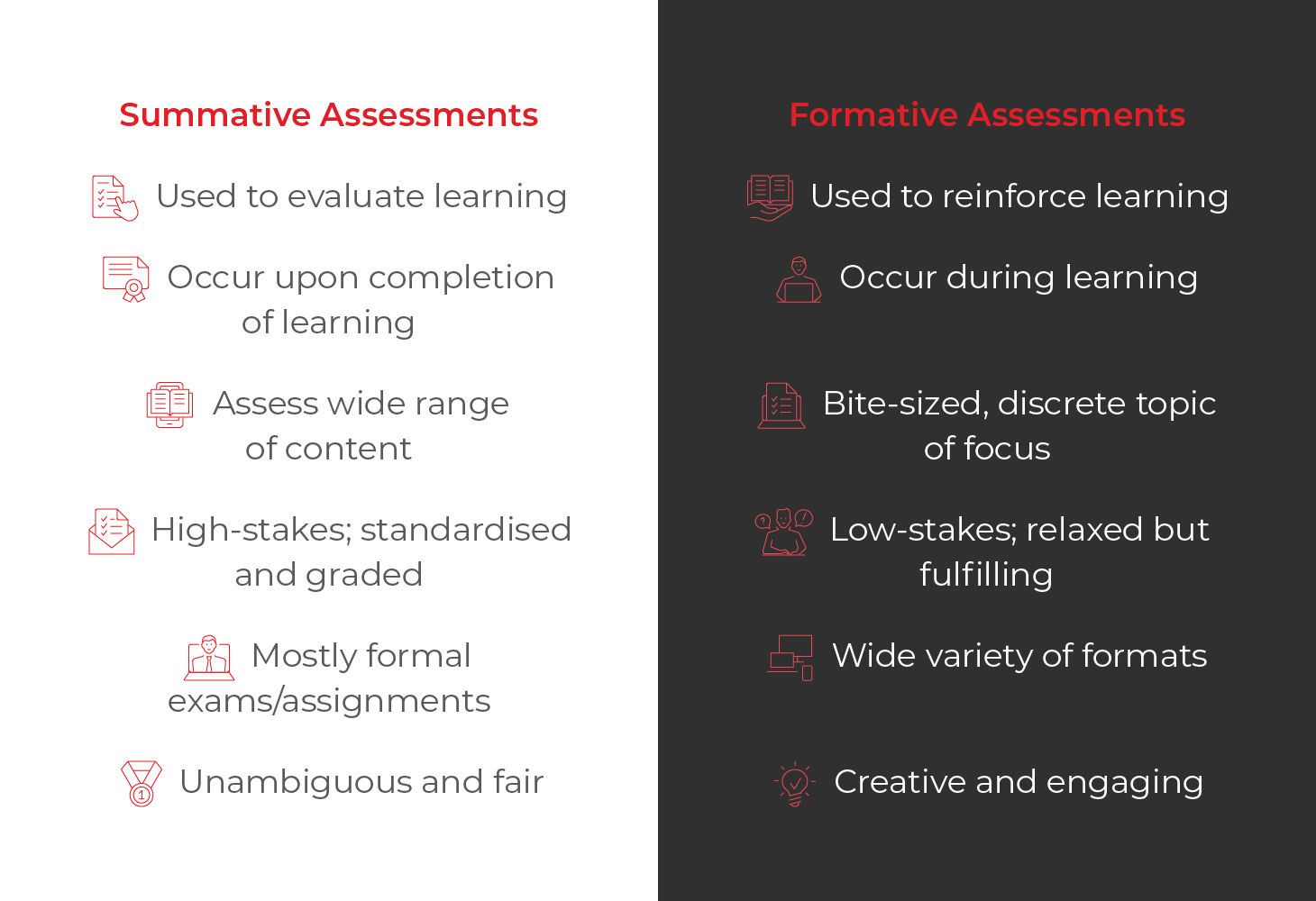Assessments are a critical element of both teaching and learning – but how should they be utilised, and what purpose do they serve in a course?
Assessments come in many different forms. They can range from potentially lifechanging high-school final exams to informal discussion boards in an online class. This can make it confusing to define their scope and purpose.
One helpful way to categorise assessments is to classify them as primarily “formative” or “summative”. Formative assessments aid the learning process – they are for learning – whereas summative assessments are an overall evaluation of learning.
These categories are not strictly binary; assessments often include elements of both. For example, a teacher may provide feedback for a final exam in order to deepen the student’s understanding even after the course concludes. Nevertheless, these definitions remain a useful tool for both instructors and students in determining the intent of assessments and how appropriate they might be for a course.
What is a Summative Assessment?
Summative assessments aim to evaluate a student’s overall understanding of a topic. These are designed to be overarching examinations of student knowledge. Due to this, summative assessments are usually infrequent – often placed at the end of a topic, course, or academic period. Simple examples of summative assessments include the American SAT or final exams of university units.
As a comprehensive appraisal of a student’s capabilities, it is imperative that these assessments are as fair to the student as possible. This is why they are commonly standardised and graded. Instructional designers should create summative assessments that allow students the greatest chance of demonstrating their aptitude and knowledge. Questions must be precise and unambiguous, crafted in a way that allows them to confidently express their understanding. This includes both the wording of the question itself, as well as the type of question used.
For example, a long-answer assessment (such as an essay) allows students more freedom of expression than a discrete-answer multiple-choice question (MCQ). This is because the format allows students to explain their understanding of the question in detail; a luxury MCQs cannot afford. Consequently, if MCQs are more appropriate for an assessment – for example, for the sake of brevity – it becomes an absolute necessity that they are worded in a way that leaves no opportunity for misinterpretation. This is because if the question is poorly framed, a student has no means of clarifying their answer if their response is deemed incorrect by the rubric.
Therefore, designers should recognise they have a duty of care to the students undertaking their assessments; since these are often time-pressured, tense environments, it’s important for tests to be formatted clearly and charitably. This should ensure that competent students are able to illustrate the full degree of their understanding without being hampered by exam stress.
What is a Formative Assessment?
In contrast, formative assessments are typically much broader in both variety and intent than summative assessments. Regardless, they all have a unifying feature – they are assessments undertaken during instruction to help supplement student learning, while also providing useful feedback to instructors. The primary goal of a formative assessment is to reinforce understanding.
Formative assessments often provide direct feedback on a particular concept an instructor wishes to highlight. Since students all learn differently, and because some concepts are better explored in particular ways, these assessments can take a wide variety of forms. For example, a formative assessment could be a simple true/false question in the middle of a module, providing instantaneous feedback and further explanation dependent upon the answer chosen. However, peer reviews, or even informal classroom debates, also count as formative assessments, and may be more appropriate dependent on the content in question. Instructors must take care to carefully select the type of formative assessment they utilise to match their intended purpose.
Simultaneously, formative assessments provide instructors insights into the level of classroom understanding; and because they are conducted contemporaneously with the learning process, this allows teachers to adjust their methods to fit students’ needs in real time. This secondary function is partially why formative assessments are so diverse – a quiz intended to provide direct student feedback is starkly distinct from a survey gauging classroom opinion on course pacing.
For a formative assessment to be effective, a student must feel encouraged to engage with it. Consequently, it is important that they are not overwhelming. A good formative assessment should be short, snappy, and low-stakes – but still feel worthwhile. If they end up arduous or unfulfilling, students may become dismissive or neglect these exercises, rendering any potential feedback useless. Students might also experience burnout, which could worsen their opinion on the course and significantly hamper their learning.
Summative vs Formative![]()

The table above summarises the primary differences between formative and summative assessments. Most of these differences have already been addressed in previous sections, but some are worth considering in more detail. It is worth reiterating that most of these are not strictly mutually exclusive – assessments often include elements of both.
As an example, although summative assessments must be strictly unambiguous, formative assessments – being low-stakes – are not bound by the same obligation. Since formative assessments often provide immediate direct feedback, “trick questions” – although usually poor practice – may actually benefit students if employed tactfully. These might allow instructors to explore important exceptions or extensions of course content in an imaginative way that captures students’ attentions.
Ultimately, there are several important differences between summative and formative assessments, and knowing the right tool to accompany the learning process is imperative to the success of a course. Formative assessments are powerful tools to help learning development and provide feedback to improve the teaching process, and summative assessments are the clearest method for instructors to analyse the level of their students’ overall knowledge. Appropriate understanding and use of both will drastically increase the quality of a curriculum.


